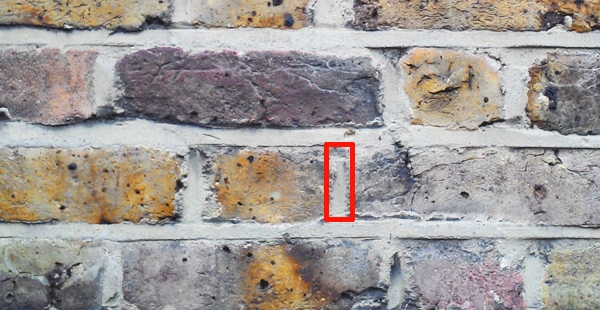Perpend
The term ‘perpend’ (perp or cross joint) refers to the vertical joints between blocks or bricks that have been laid in a horizontal course to form a wall. Perpends are normally filled and sealed with mortar. The horizontal mortar joint in a wall construction is typically referred to as the bed joint.
Rather than being filled with mortar, perpends may also be left open to form weep holes or cavity ventilators. These provide openings that allow the drainage of moisture from within a wall construction and allow ventilating air to the back of a wall to help prevent mildew, dry rot and damp. They are generally formed by plastic inserts into the perpends, as these form a more uniform opening compared to simply leaving a void. See weep holes for more information.
A perpend stone is a long stone that extends between the inner and outer layers of a stone wall, tying the two layers together. The stone is ‘dressed’ at both ends.
The term ‘perpend’ may also be used more generally to refer to any brick or stone the longest dimension of which is perpendicular to the face of the wall. See bond stone.
The expression “keeping the perpends” is a term used to describe what happens when cross joints or transverse joints in brickwork are maintained in a perpendicular line.
[edit] Related articles on Designing Buildings Wiki
Featured articles and news
The UK's Modern Industrial Strategy: A 10 year plan
Previous consultation criticism, current key elements and general support with some persisting reservations.
Building Safety Regulator reforms
New roles, new staff and a new fast track service pave the way for a single construction regulator.
Architectural Technologist CPDs and Communications
CIAT CPD… and how you can do it!
Cooling centres and cool spaces
Managing extreme heat in cities by directing the public to places for heat stress relief and water sources.
Winter gardens: A brief history and warm variations
Extending the season with glass in different forms and terms.
Restoring Great Yarmouth's Winter Gardens
Transforming one of the least sustainable constructions imaginable.
Construction Skills Mission Board launch sector drive
Newly formed government and industry collaboration set strategy for recruiting an additional 100,000 construction workers a year.
New Architects Code comes into effect in September 2025
ARB Architects Code of Conduct and Practice available with ongoing consultation regarding guidance.
Welsh Skills Body (Medr) launches ambitious plan
The new skills body brings together funding and regulation of tertiary education and research for the devolved nation.
Paul Gandy FCIOB announced as next CIOB President
Former Tilbury Douglas CEO takes helm.
UK Infrastructure: A 10 Year Strategy. In brief with reactions
With the National Infrastructure and Service Transformation Authority (NISTA).
Ebenezer Howard: inventor of the garden city. Book review.
The Grenfell Tower fire, eight years on
A time to pause and reflect as Dubai tower block fire reported just before anniversary.
Airtightness Topic Guide BSRIA TG 27/2025
Explaining the basics of airtightness, what it is, why it's important, when it's required and how it's carried out.
Construction contract awards hit lowest point of 2025
Plummeting for second consecutive month, intensifying concerns for housing and infrastructure goals.
Understanding Mental Health in the Built Environment 2025
Examining the state of mental health in construction, shedding light on levels of stress, anxiety and depression.






















